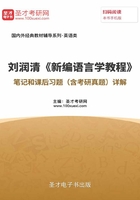
第3章 形态学
3.1 复习笔记
本章要点:
1.Definition of Morphology
形态学的定义
2.Definition and Classification of Morphemes
词素的定义及分类
3.Morphs and Allomorphs
词素变体
4.Types of Word Formation
词语构成的分类
常考考点:
词法的定义;曲折词与派生词;构词法(合成与派生);词素的定义;词素变体;自由词素;粘着词素(词根,词缀和词干)。
本章内容索引:
I. Morphology
Definition of Morphology
II. Morphemes
1.Definition
2.Types of Morphemes
(1) Free morpheme
(2) Bound morpheme
III. Morphs and Allomorphs
Definition of Morphs and Allomorphs
IV. Types of Word Formation
1.Compounding
2.Derivation
3.Other ways of word formation
(1) Conversion
(2) Backformation
(3) Clipping
(4) Blending
(5) Acronym
(6) Initialism
I. Morphology形态学
【考点:名词解释】
Morphology, as a branch of linguistics, is the study of the internal structure, forms and classes of words.
形态学作为语言学的一个分支,是研究词语的内部结构,形式及分类的一门科学。
II. Morpheme语素
1.Definition定义
Morpheme is the smallest unit of language, a unit that cannot be divided into further smaller units without destroying or drastically altering the meaning, whether it is lexical or grammatical.
语素是最小的语言单位,不能再进一步分成更小的单位而不破坏或彻底改变词汇意义或语法意义。
2.Types of Morphemes (语素的类型)
(1) Free morpheme (自由语素)
【考点:名词解释】
①Free morphemes are those which may occur alone or constitute words by themselves. All monomorphemes are free morphemes and polymorphemic words, which consist wholly of free morphemes, are compounds.
②A word must contain an element that can stand by itself, that is, a free morpheme, such as talk. Such an element is called a root. A word may contain more than one root.
③When they are used with bound morphemes, the basic word-form involved is technically known as the stem.
④Free morphemes can be divided into two categories. The first one is the set of ordinary nouns, verbs and adjectives which carry the content of messages we convey. These free morphemes are called lexical morphemes and, since we can create new lexical morphemes for the language rather easily, they are called an open class of words.
⑤The second category of free morphemes are called functional morphemes. As we almost never add new functional morphemes to the language, they are called a closed class of words.
①自由词素指能够单独出现或独立成词的语素。所有的单语素词都是自由语素,由自由语素构成的多语素词为复合词。
②可以独立成词的部分,也就是自由词素被称作词根,一个词可以包含多个词根。
③当自由词素和粘着词素连用时,最基本的部分称作词干。
④自由词素分为两类。一类是表达实义的名词,动词和形容词。它们被称作词汇词素。这类词素可以创造新词,因此属于开放式词汇。
⑤第二类叫做功能词素。功能词素几乎不能创造新词,因此属于封闭式词汇。
(2) Bound morphemes (粘着语素)
【考点:名词解释】
①Some morphemes cannot normally stand alone, but function only as parts of words, e.g. -s, -er, -ed and -ing. Such morphemes are called bound morphemes
②Bound morphemes are actually affixes. All affixes in English are bound. Affixes can be joined to the beginning of the root or stem, in which case they are called prefixes. Prefixes can change the meaning or function of the word..
③Affixes can also be joined to the end of the root or stem, in which case they are called suffixes. Suffixes can also change the meaning or function of the word.
④Bound morphemes can be classified into two categories. One category is derivational morphemes, which are used to make new words in the language and are often used to make words of a different grammatical category from the stem.
⑤The other category is inflectional morphemes, which are not used to produce new words, but rather to show aspects of the grammatical function of a word.
①一些词素不能够单独成词,但会起到一定的功能作用。这种语素叫做黏着语素。
②黏着语素相当于词缀。英语中所有的词缀都是黏着的。附着在词根或词干前面的词缀叫做前缀,前缀可以改变词义或词语功能。
③词缀还可以放到词根或词干的后边,形成后缀,后缀也可以改变词义或功能。
④黏着语素可以分为两类。一类叫做派生语素,用来创造与词干分属不同语法类别的新词。
⑤另一类叫做曲折语素。屈折语素不用来创造新词,而是体现一个词的不同语法功能。
III. Morphs and Allomorphs (语素和语素变体)
Morphs are the smallest meaningful phonetic segments of an utterance on the level of parole.
An allomorph is a member of a set of morphs which represent the same morpheme. Allomorphs are phonological or orthographic variants of the same morpheme.
语素变体是最小的有意义的语音单位。
那些代表同一语素的不同形素叫做该语素的语素变体。
IV. Types of Word Formation (构词法)
【考点:词的形成方法】
1.Compounding (复合词)
By means of compounding, two free morphemes are combined to form a compound. Compounds have strict patterns. The first element in the compound receives the main stress, but it is generally the second element that determines the compound’s new word class.
两个自由语素结合形成复合词。复合词有严格的形式。复合词的重音在前一部分,但词义通常由第二部分决定。
2.Derivation (派生词)
Derivation is done by adding affixes to other words or morphemes. In contrast to compounding, a derivational word consists of at least a free morpheme and a bound morpheme.
派生词是通过添加词缀来形成的。和复合词不同的是,派生词至少包含一个自由语素和一个粘着语速。
3.Other ways of word formation (其他构词法)
①Conversion (转换法)
Many words have more than one part of speech. A noun can become a verb easily and a verb can be used as a noun. Such instances are called conversion.
Conversion is also called zero derivation.
很多词语包含多种词性。名词和动词之间可以相互转换,这种构词法叫做转换法。转换法又叫做零派生。
②Backformation (逆序造词)
There are times when we remove a suffix to get a new word. For example, as we have editor, we get edit by dropping or. This process is called backformation.
有些时候我们可以通过去除后缀来得到新词,这个过程叫做逆序造词。
③Clipping (截断法)
The process by which parts of a word have been cut off is called clipping. Clipping occurs when a word of more than one syllable is reduced to a shorter form, often in casual speech.
把词语的一部分省略掉叫做截断法。多音节词汇变成形式较短的词汇,这种形式通常出现在非正式用语中。
④Blending (混成法)
A single new word can also be formed by combining two separate forms. This process is usually called blending. Typically, blending is finished by taking only the beginning of one word and joining it to the end of another word.
两个独立的形式相结合构成新词,叫做混成法。通常,混成法是结合了一个单词的开头和另一个单词的结尾。
⑤Acronym (首字母缩略词)
Some new words are formed from the first letters of a series of words. They are pronounced as a single word.
通过几个单词的首字母结合而成的单词叫做首字母缩略词。这类词可以以词的形式发音。
⑥Initialism (首字母缩写词)
Some new words are composed of the first letters of a series of words and pronounced by saying each letter in them. These kinds of words are called initialisms.
首字母缩写词由几个单词的首字母组成,要以单个字母来发音。